According to Hindu scripture, during the great battle of Lanka, Hanuman, the monkey god, was in trouble. He had been captured, and fires raged all around. Help came in the unlikely form of a troop of Grey Langurs, who rushed to assist Hanuman, resulting in scorched black faces, and a revered status in Hindu culture that persists to this day.
While visiting the great north Indian state of Rajasthan, I traveled from Jaipur to Ranthambhore National Park, chasing a dream of seeing a wild Royal Bengal Tiger. Ranthambhore oozes history, spirituality, and a spellbinding sense of the exotic. Since 1754, the wilderness now known as Ranthambhore National Park, was maintained as the private hunting preserve of the Maharajas of Jaipur. In 1980 the Indian government declared the 392 km² (150 square miles) area a National Park, dedicated to the protection of tigers.

On the first drive through the park I encountered Grey Langurs in their natural habitat, standing guard from treetops, barking a tiger alarm to wildlife foraging below. It was not until later, when visiting UNESCO site, Ranthambhore fort, that I began to understand the cultural significance of this animal.
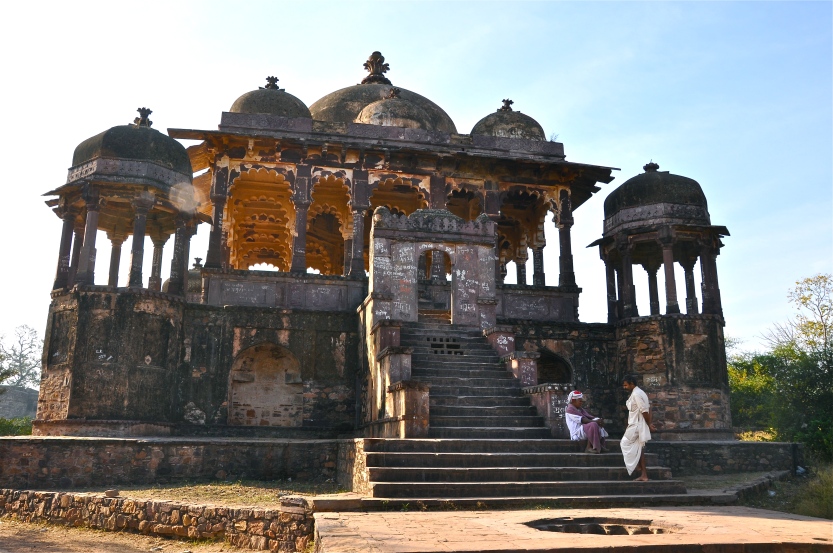
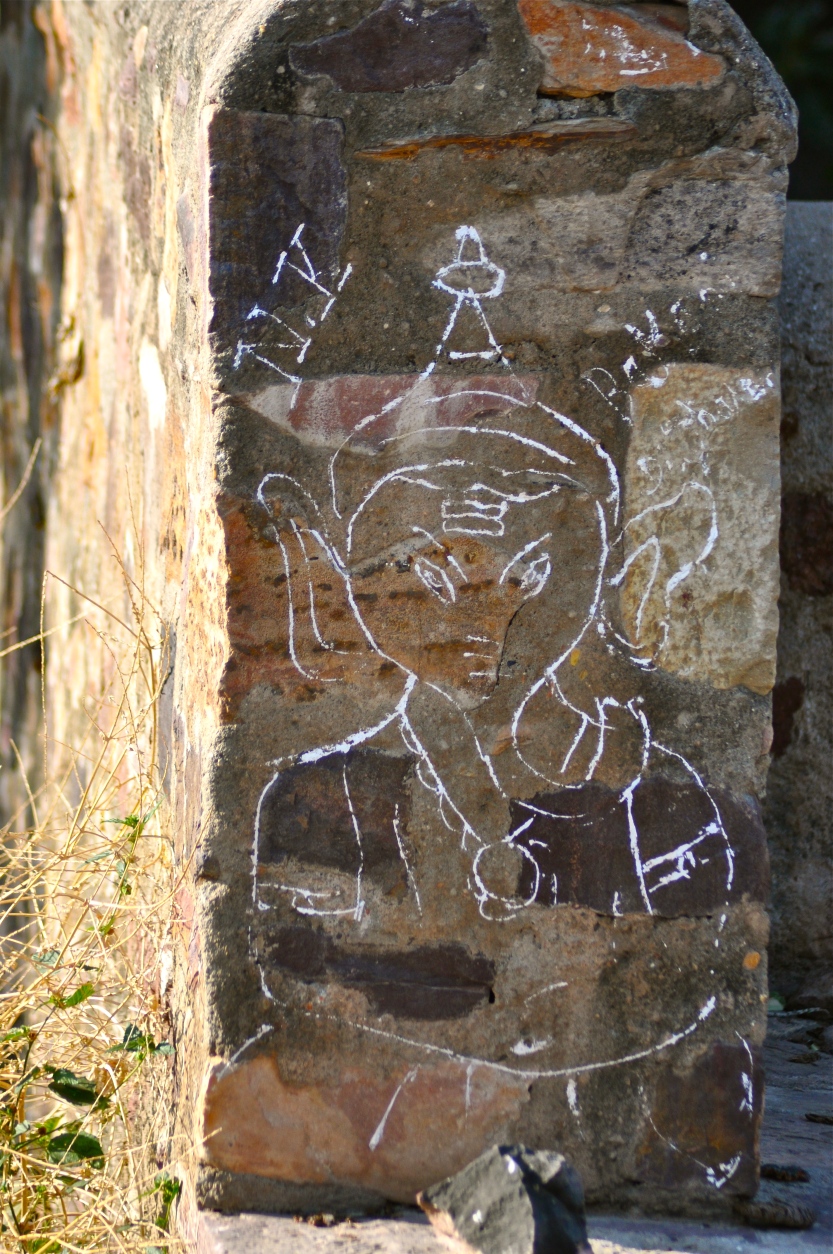
Ranthambhore fort is within the national park boundary, with access to the old fort ruins only possible by foot. As I approached the main area of the ruins, I was struck by three things: It was clearly a place of intense worship, there were clouds of pigeons, and there were langurs, everywhere.
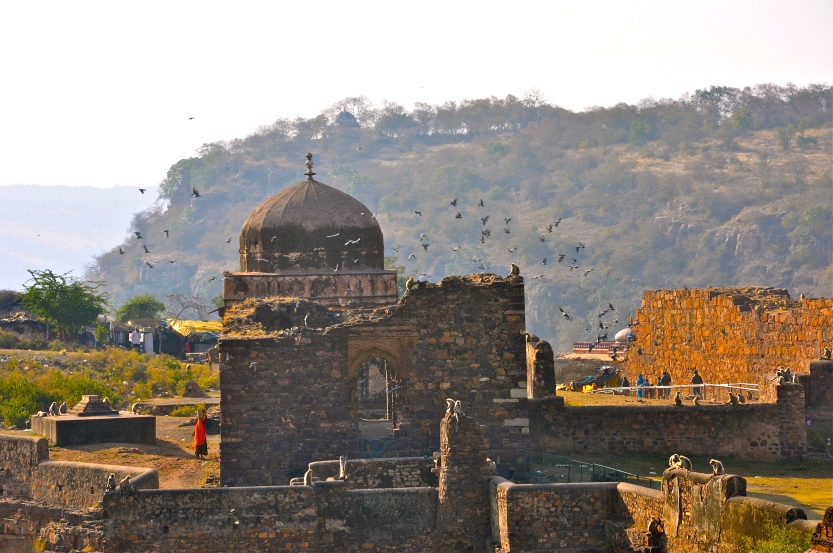
I arrived at the main ruins to find every stretch of wall adorned with monkeys, like statues, in the amber glow of the Indian sun. It is an intimidating experience to walk through a huge troop of monkeys that are studying your every move. I had encountered troops of macaques in other parts of Asia, and knew that they could be very aggressive. It felt like a scene from the movie Apocalypse Now, arriving at Colonel Kurtz’s jungle camp while his warriors look on in impassive silence. Very quickly I realized that these monkeys are not aggressive as they sat, relaxed and somewhat disinterested.
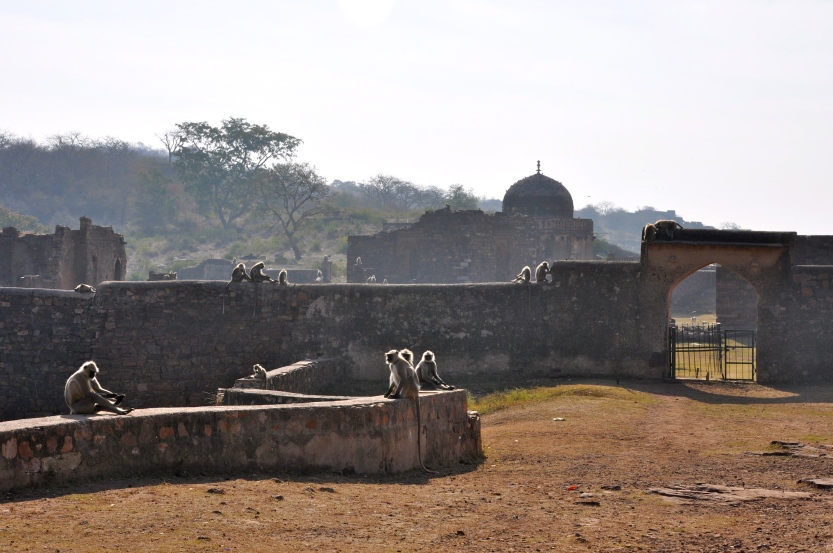
I was able to approach the langurs, and get very close without them showing even the slightest concern. When revered as a warrior of the gods it appears that you have very little need to be fearful of humans.
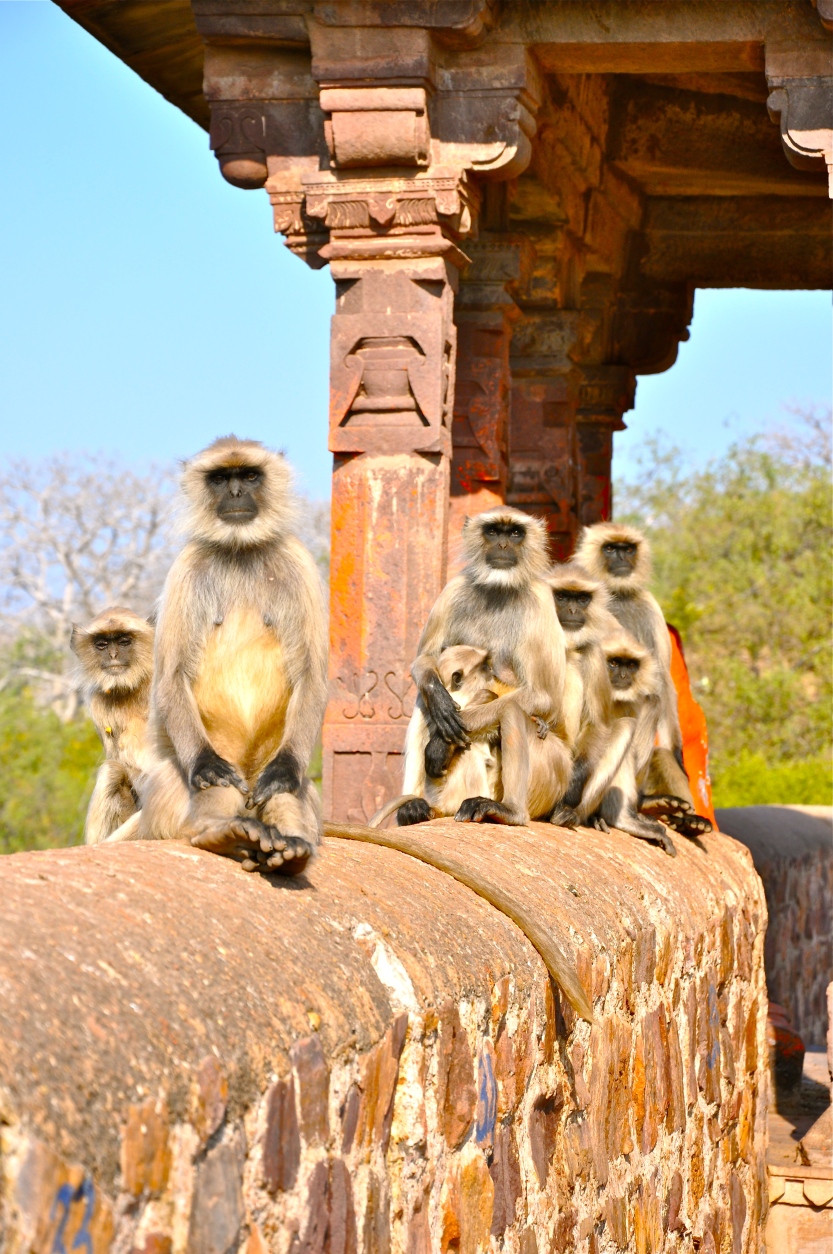
Small groups of langurs positioned themselves along the main walking path, through the ruins, to the temple at the far end of the fort. I walked the path, entered the temple and paid my respects to an orange painted icon of Hanuman. I shared no language with the guardians of the temple, but as is so often the case, we communicated through smiles and human values. I was given a sweet, spiced offering with a motion to eat it. Some offerings were taken by worshipers to the langurs along the path. Perhaps this partly explained the reason for the guard of honour that they gave to worshippers.

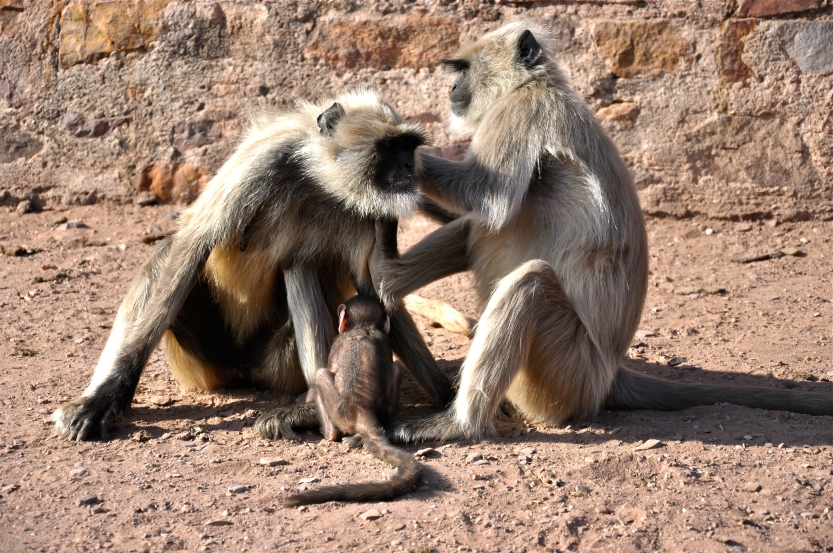
The langurs spent large amounts of time grooming one another, sunbathing or (as seen below) just airing themselves in the fresh air and gentle warming sunshine of a December morning.
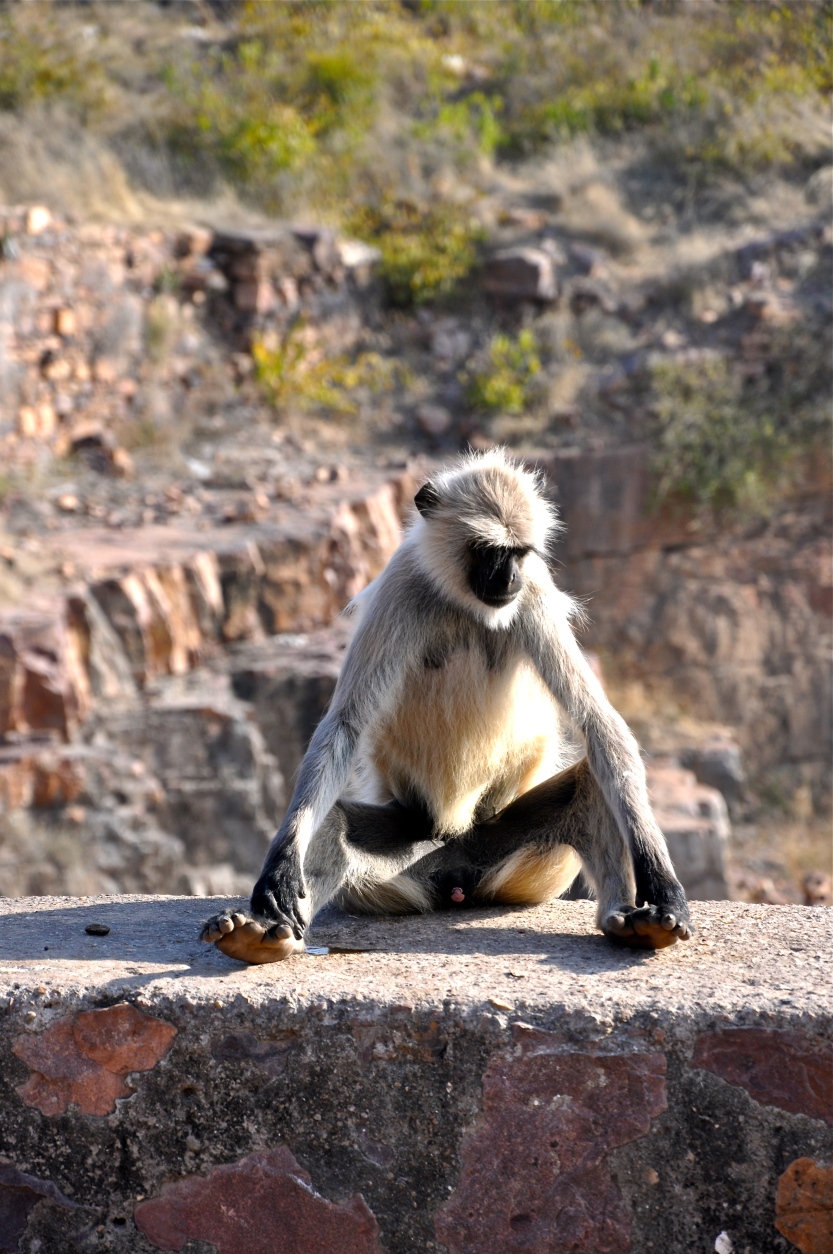
The Grey langur is a large primate, growing to around 68 cm (27 inches) in height, and weighing in at around 17 kg (37 lbs), with males a little smaller than females. They have been recorded as living for over 30 years, which is not surprising considering the life of luxury they appear to enjoy.
It isn’t all peace and relaxation in the monkey troop. The entire adult group is female, presided over by one Alpha male. It appears to me that he has three duties in life which are to protect the troop, rest frequently, and mate with every female as often as possible. He certainly appeared to take two of his jobs very seriously, setting about them with a steely determination. This may seem like an idyllic life for the Alpha, but reality is that he will only hold this position for around eighteen months, at which time a new boss will take over. The new Alpha’s first job is to kill the infants in the troop. This grizzly behaviour ensures that his reign is successful in producing his own young as soon as possible, and in doing so, guaranteeing the future of his genes.
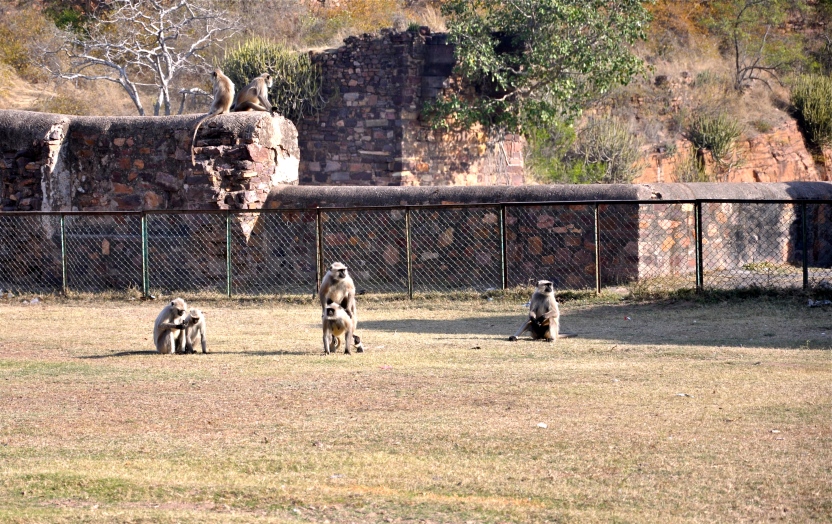
India is hot, and dry, and liquid isn’t easy to come by. Back at the car parking area a leaky tap provides a welcome drink for thirsty langurs. They wait in line and take turns to drink.

Even the babies need a drink from time to time, to compliment mum’s milk. This little guy (below) waited patiently for mum to slake her thirst first.
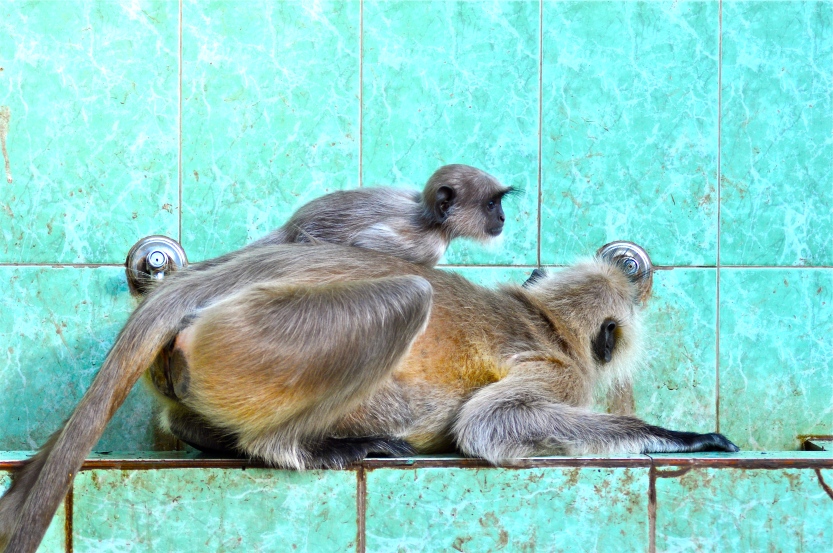
As I walked to the exit of the fort I watched a powerful demonstration of the reverence in which this monkey is held. A family walked the stone path, carrying a bag of belongings, including a snack or two. A large, active monkey leapt down from the walls above, and with the sense of entitlement of a spoilt child, ripped open the bag, looked inside and grabbed what it wanted. In some cultures it is not difficult to imagine this behaviour being met with a swift kick. Here the moment was met with mirth from the ladies and the unlikely scene of the man reasoning with the monkey that perhaps this wasn’t the most appropriate behaviour to engage in.
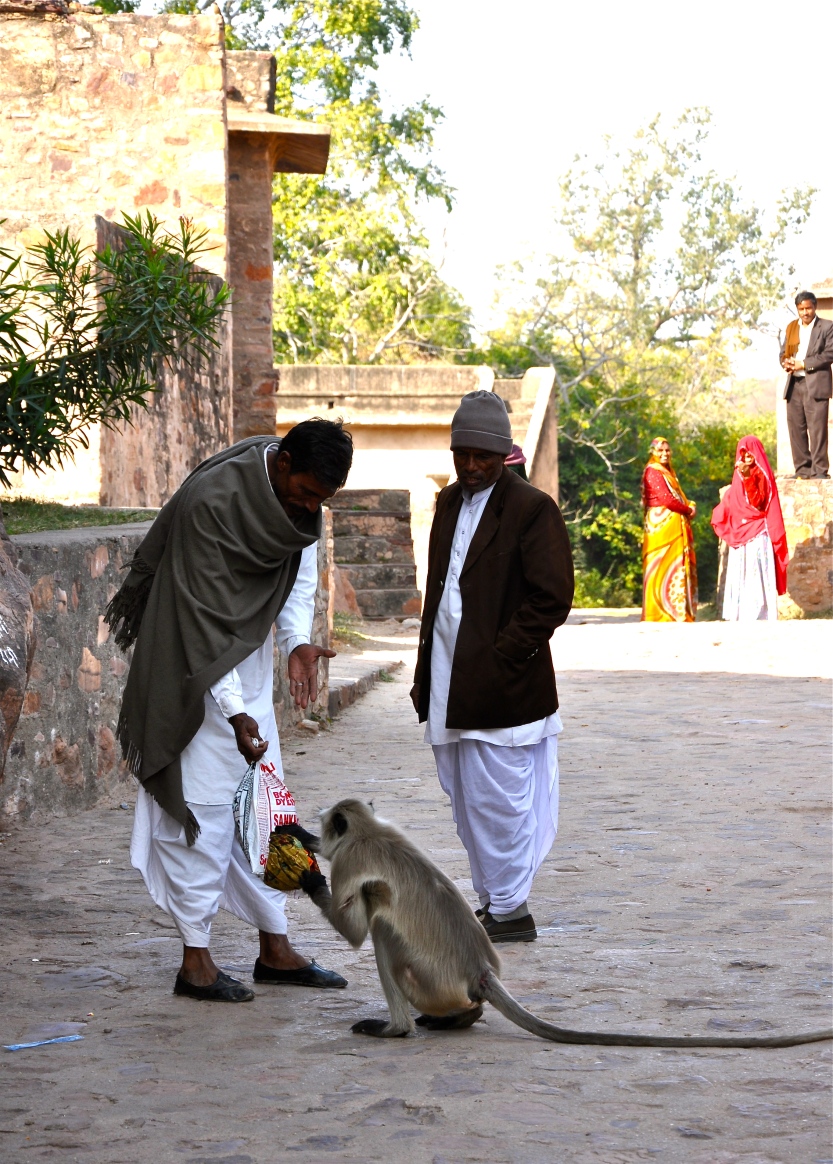
The Grey langur is protected by Indian law, despite being listed as ‘Least Concern’. While I welcome this protection, it feels a little unnecessary as it is clear that it is respect for this revered creature that guarantees its ability to survive and thrive. The belief that the god Hanuman protects Hindus ensures that in turn the Hindus protect Hanumans warriors. If a Grey langur is found dead a funeral service is held with the same level of service and dignity afforded to a human.
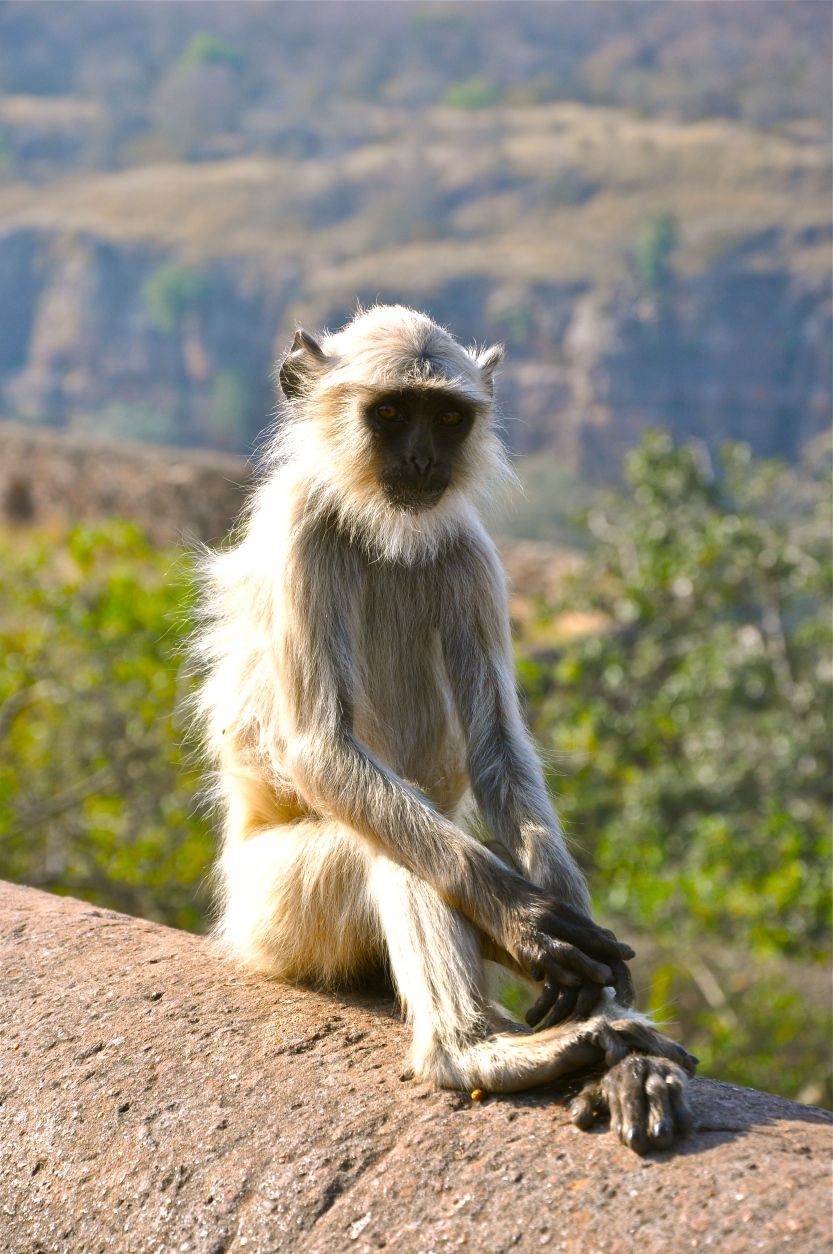
My own experience of the Grey langur was not one of a warrior monkey charging selflessly into great battles between gods. When I looked into the face of this young monkey (above) all I could see was a beautiful, shy creature, surviving in the same world that I am, in its own way. One wonders, though, what that world could look like if all wildlife was afforded the same respect that has been afforded to the Grey, or Hanuman Langur.
If you enjoyed this post, please follow Incidental Naturalist.
Comments below are welcomed.
Help others to connect with wildlife experiences by sharing this post on social media.
Categories: Asia
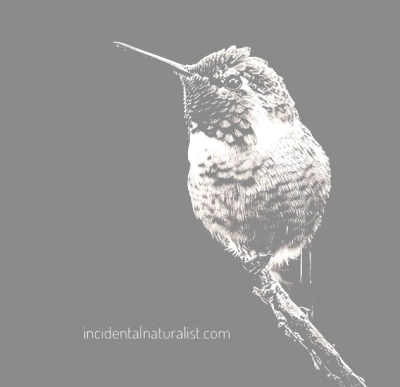




Wow, David! I feel like I just took an amazing trip! Thank you for the beautiful photos, so sharp and clear; the learning, which I always appreciate so much; and the enjoyment =)) Your descriptions and working make it easier to feel and imagine the experience! And always love your mission of education and continued support of the natural world. We are all in it, not separate from or above it. Thanks again!
LikeLiked by 6 people
Thanks again for you great comment, Lara! “We are all in it” is absolutely spot on. I’m happy that you got a sense of what it was like to be on this extraordinary trip. It really is an incredible place that you really do feel.
LikeLiked by 3 people
Grateful to have you share it so I can experience it armchair style, David!
LikeLiked by 3 people
One of the friends I made while in Belize was a Hindu man originally from Nepal. There were no langur monkeys around, but I was struck by how differently he acted towards living beings than most of the other people I met. He seemed to have more of a “live and let live” mentality, even to the point of actively planting fruit trees in empty lots. That sort of behavior was not overly common.
My observations of my friend, and other bits of information I’ve come across (like this post), make me quite interested to travel to India and/or Nepal. I’m curious to see how people treat the natural world there, and if it differs in any way from my previous experiences.
LikeLiked by 4 people
Hi josh, thank for the comment! My India articles have rightly focused on the Royal Bengal tiger and these amazing langurs, but what I haven’t written about is the everyday interactions with wildlife that I witnessed. I saw huge, urban populations of rats, mice, pigeons, and squirrels living in colonies, unharmed by local people. Huge kites swooped down to grab scraps of meat or fish in the markets of Mumbai, without fear of being shot, trapped or poisoned. I really experienced a sense of living together with nature. I have not been to Nepal (yet) but I certainly recommend India. Not everyone can enjoy it because of the terrible conditions that some people live in, but I loved the place! I know that you would love spending time in the company of tigers.
LikeLiked by 3 people
I’ve always wanted to go to India, but figured it’d be something I do later in life. But after spending time with my Nepalese friend, I want to get to that part of the world as soon as possible. I felt like I was among a kindred spirit, in regards to his reverence for life. And then there are the Himalayas, which I would love to be able to explore.
LikeLiked by 4 people
The Himalayas are calling me, always! 🙂
LikeLiked by 2 people
Thank you for an interesting post. I too wish more human primates would respect other primates and wild creatures. The last picture is lovely. How special to be observed in such a relaxed fashion with such quiet regard by an animal that has not learnt fear and defensiveness, in contrast to persecuted monkeys in other parts of the world, including where I live in South Africa.
LikeLiked by 4 people
Thank you for sharing –
LikeLiked by 3 people
Great read!!!
LikeLiked by 3 people
So well expressed that seemed like traveling myself. Langurs are common sight in Shimla too.
LikeLiked by 4 people
Thank you, Namrata! I am delighted to have taken you on the journey. These langurs are remarkably widespread. I have seen them in Sri Lanka, too. It is good to see a monkey that can thrive alongside us.
LikeLiked by 2 people
Hi, loved your article on grey Langurs written with humor and respect to our hairy ancestors. Being a Hindu myself I can validate the fact that they are somewhat revered in some parts of the country as Hanuman’s warriors. There are certain places of worship in India where monkeys are somewhat of a mild menace – snatching what they find exciting from visitors. But all in all they are so cute, they remind of our friendly dogs with an attitude.
LikeLiked by 4 people
Thank you for this wonderful comment. I am particularly pleased that you have validated my interpretations of the Hindu view of these “hairy ancestors”. It is uncertain ground when gently tiptoeing in to someone else’s religion. Especially when so much that is written is written in a language that is foreign to me. They are very cute indeed!
LikeLiked by 3 people
hiii neha kindly visit my blog for a amazing destination of rajasthan !!
LikeLiked by 1 person
Amazing photos and story. Your story kind of made me feel as though I were there. Nice work.. 🙋🐦
LikeLiked by 4 people
I’m very happy to have taken you on the journey! 🙂
LikeLiked by 3 people
What a wonderful experience, both the subjects and the location! A very good read. We would love to visit someday. Thanks for sharing 🙂
LikeLiked by 3 people
Thanks for the kind comment! It really is a wonderful part of the world. Sometimes confronting, but mind bogglingly beautiful. Kind people, too!
LikeLiked by 3 people
Thank You Thank You THANK YOU! I was blessed to spend a couple of months in India a few years ago. Your photos are beyond magnificent. You took me right back. Gorgeous. 🙂
LikeLiked by 1 person
Thanks for the wonderful comment! I’m very happy to have taken you back to that incredible place 😊
LikeLike
hiii plzz visit my blog to knw abt a beautiful place of india!!
LikeLike
Love it! The grey langurs and the reverence for them is so fascinating. I absolutely love India and Nepal and the whole Hindu culture. Thank you for sharing!
LikeLiked by 1 person
helloo!!! plzz visit my blog for beautiful destination of India!!
LikeLike
Great article, I enjoyed learning about the transition from one Alpha male to another. It gives us humans incredible insight about how the natural/primate world works like. Definitely following you, thanks for the great article man!
LikeLiked by 1 person
Thanks for the encouraging comment. I’m very happy to welcome you as a new follower!
LikeLiked by 1 person
No problem :)!
LikeLike
Hey… Your post is great, being an Indian myself, I must say that our hairy ancestors are cool enough along with a little naughtiness! Afterall they are the mighty Lord Hanuman’s warriors! Too much Pleased to see the post!!
LikeLiked by 1 person
Thanks for the kind and encouraging comment! 😊🐒🐒🐒
LikeLike
hii kumar visit my blog plz for a beautiful indian destination!!
LikeLike
Hey Nami, I followed ur blog and would love to help u in any way I can. Hope u like mine blog too😊😊
LikeLiked by 1 person
thanks kumar for support!!
LikeLike
Most welcome
LikeLiked by 1 person
Nice post . 😇
LikeLiked by 1 person
It is always fun to watch langurs or any similar species. They teach a lot us.. being close to each other and caring.
LikeLiked by 1 person
It is true! In every behaviour we can see a human behaviour. There is much to learn if we care to learn it. Thanks for your comment!
LikeLiked by 1 person
You are brave. I would have passed out at the sight of all those monkeys.
LikeLiked by 2 people
They were pretty relaxed, once you get passed the initial shock! 🐒🐒🐒🐒
LikeLike
Splendid post. What a lovely set of images and narration.
LikeLike
Thank you for the kind, and encouraging comment! 😊
LikeLike
hiii subham plzz visit my blog for a beautiful destination!!
LikeLike
Hi I am from rajasthan jaipur ..
and enjoyed reading your encounter with langurs….
LikeLiked by 2 people
Hi Nikki, it means a lot to me that this article resonates with someone from the beautiful state of Rajashan. For me, the Pink City of Jaipur is a truly splendid place. The langurs are a monkey of the forest. You have your own monkey trouble in the city with those Rhesus macaques! 🐒
LikeLiked by 1 person
hii david i really liked ur article for a beautiful destination of rajasthan kindly visit me!!
LikeLiked by 1 person
hii nikki u r from rajasthan thn plz must visit my blog too!!
LikeLike
sure..
LikeLiked by 1 person
thanks 🙂
LikeLike
Thank you for sharing that. I loved reading it and seeing the photos of their beautiful faces and I’m wishing to be able to relax like that.
LikeLiked by 3 people
Thank you for the kind comment. They really do have a beautiful serenity about them. We could all use a little more of that.
LikeLiked by 1 person
Nice post with great photos.
LikeLiked by 2 people
i will just say it in one word “INCREDIABLE INDIA” where “UNITY IN DIVERSITY”
LikeLiked by 3 people
hiii subodh for a beautiful destination of rajasthan visit my blog plzz
LikeLiked by 1 person
hii subodh…plz visit my blog for a beautiful destination of India!!
LikeLike
I love the photo
LikeLiked by 1 person
We here in India pray Shri.Hanumanji. He is the God of Strength and Wisdom. His one of the quality as disciple of Bhagwan Shri. Ram
LikeLiked by 2 people
Thank you for adding to this conversation with a little more information.
LikeLike
My pleasure Sir.🙏.
LikeLike
enjoyed your work here
LikeLiked by 1 person
Rajasthan is undoubtedly best state to visit . As it includes Blend of desert mountains n dense forests having different variations. Hometown of mine is also known as Venice of India
LikeLiked by 2 people
That is superb article
LikeLiked by 2 people
Hi David
Loved the post especially since the monkeys around Bangalore North near the university where I work have been especially active since the hostelers returned to their rooms. Smart move!
LikeLiked by 2 people
Thank you for teaching me more about the Monkey God.
LikeLiked by 2 people
I absolutely love this post! We are currently living in Sri Lanka and our little house is nestled in nature. We often get groups of gray langurs coming to visit mostly due to the huge jackfruit trees that are on the property and which they absolutely love to eat when they are ripe. The langurs as you came to observe, are not aggressive and do not usually bother humans in the way other types such as macaques might.
We have spent time in India and I too was fascinated with the monkeys which hang around scared sites, one such was the Sacred Lake in Pushkar where we spent several weeks. Thank you for the interesting history and information much of which was new to me. Your photographs are absolutely gorgeous ~ So enjoyed them!
Peta
LikeLiked by 2 people
Hi Peta, thank you for this wonderful comment. You’re so lucky (I’m certain that you made your own luck) to be living in Sri Lanka. I loved it there! So much wildlife. I have some posts from Sri Lanka (Blue whales, Elephants, Peacocks, Bee Eaters) which you might be interested in. Thanks for you kind words. I’m very happy to introduce you to some new information on your local wildlife. Cheers, David.
LikeLiked by 1 person
These monkey’s army even assisted God Rama to build the pool to pave the path of Lanka (shree Lanka) in Ramayana and later they fought against army of Ravana. Even tiger has religious symbolism in Hindu mythology, known as ride of goddess Durga. I liked your perception here about how in friendlier way Indian people treat these animals
LikeLiked by 3 people
Thank you for your deeper insights into Hindu symbolism and mythology. It is very important for me to know that I have not taken to many missteps in this unfamiliar territory 🙂
LikeLike
hiii leena visit me oncefor a beautiful destination of rajasthan!
LikeLike
Really great post, having never been to India your photos and experience sound incredible, definitely a side I haven’t seen before
LikeLiked by 3 people
Thanks for the kind comment! Hopefully this little taste of India will inspire you to visit some day.
LikeLiked by 2 people
heyyyto knw more abt india visit my blog for a beautiful destination of india
LikeLiked by 2 people
heyayaa visit me for a beautful destination of india
LikeLike
Thank you for sharing! Especially loved the pictures… the park is so beautiful and the grey langurs so regal!
LikeLiked by 1 person
Muy bueno
LikeLiked by 1 person
Great one dear… Thx for the real kind words. We hindu people looks for God in everyone.
LikeLiked by 1 person
Hi David, Love these incredible furry creatures, their tresses and bold stares equally! Beautifully captured.
LikeLiked by 2 people
Thanks for being my tour guide into the wild!
Lovely post
LikeLiked by 1 person
Waoo nice 👍
LikeLiked by 1 person
This was an excellent read David, you just took me there ! A piece of flowing narration about systematically gathered information. Photos are beautiful too.
May I humbly seek the permission to add a few bits to this ?
The males in a harem, except the alpha appear smaller than females because they are very young and immature. The matured youngsters are invariably ousted from the troop by the alpha to keep his supremacy.
These bachelors form their own group. Occasionally they would raid a troop, force some females to mate, if the get a chance, by dodging the alpha. During such raids sometimes the supremacy of the alpha is toppled and a new leader takes over.
Thanks once again for the intriguing journey !!
LikeLiked by 1 person
Thank you for your very kind and encouraging comment, Mohit. Thanks also for the additional information, which I am always happy to receive.
LikeLiked by 1 person
Love it! Beutiful, Awesome and much more…..I don’t have words..
LikeLiked by 2 people
Thank you so much for the kind words! 😊
LikeLike
heyaa kindly visit me onceto knw abt a beautiful place of rajasthan!!
LikeLike
Great photography..loved it👍
LikeLiked by 2 people
hiii mehak plzz visit me once to explore the beauty of rajasthan!!
LikeLike
Amazing pictures.. 🙂
LikeLiked by 2 people
hiii malika visit me once to knw abt a beautiful destination of rajasthan!!
LikeLike
Visited your blog, didn’t know mandava is such an amazing place. 🙂
LikeLiked by 1 person
ya dear is Mandawa is such a amazing place …thts y m spreading its beauty here!! 🙂
LikeLiked by 1 person
Amazing, David.. it seems I am there. Nice clicks and I liked most as hanuman bhakt( devotee) also
LikeLiked by 1 person
Thank you for your kind words, Durgesh 😊
LikeLiked by 1 person
Welcome dear friend😊
LikeLike
Take time to read my blogs need your feedback and guidance on my blogging journey
LikeLiked by 1 person
Such a thought provoking article…the intent as well as the content is indeed very refreshing. I stay at Assam, which is also the land of the golden langur, gorgeous creatures they are as well…I could definitely relate. Looking forward to reading more posts from you.
LikeLiked by 1 person
Thank you for this encouraging comment! I’m very happy that you enjoyed the intent and content, and that you feel you can relate. 😊 welcome to my blog, I hope you enjoy!
LikeLike
Monkeys wow 🙂
LikeLike
Great thanks
LikeLiked by 1 person
The monkey forest in Ubud, Bali, was my favorite spot.
LikeLiked by 1 person
Yes, that is a fascinating place, I the macaques in the Monkey Forest are a little less relaxed than these guys 😳😄
LikeLike
Yes.. They grabbed my purse and nearly decapitated me as it was slung over my neck. Next time I took only postcards and a pen to write to my stepkids and one big guy came and grabbed my cards and bit them, then threw them on the ground. Bully. The kids LOVED getting postcards with monkey teeth impressions in them!
LikeLiked by 1 person
Haha! I’m sure the kids would love monkey bite cards. That is definitely a personalized card. Those monkeys are very bold. I’m sure someone will get injury them someday. Never take food, bottled liquid or a bag that they can grab. 😄🐒
LikeLiked by 1 person
They need a sign warning of the dangers, don’t you think?
LikeLiked by 1 person
I think there were a few signs. Darn monkeys don’t read them, though!! 😉 I used to encounter macaques regularly in Singapore. They were always a little bit more confident than I liked. Whenever I looked through the view finder I was nervous that one would pounce on me while I was distracted. Very different from these chilled langurs.
LikeLike
Yes. They are so stoic looking and alert. Great posture.
LikeLike
Very informative and interesting reas on the Grey Langur. Despite being an Indian, I haven’t had the opportunity to travel to Ranthambore. Reading your writing was like taking a trip. Have seen the revered creatures all over Sri Lanka and in most parts of India and they can be agressive and difficult. They one snatched an ice-cream from my sister’s hands.😊
LikeLiked by 2 people
Thanks for the great comment! I’m happy to have taken you on a journey. 😊 ha! Never never never trust a monkey when there is food around 🐒🍦
LikeLike
😊 never again David.
LikeLiked by 1 person
hiii smitha v plzz visit me to knw abt a beautiful destination of rajasthan!!
LikeLike
Sure Nami. Will check out your blog.
LikeLiked by 1 person
thank uhh dear 🙂
LikeLike
You have captured the essence of Ranthambore, and the langurs which are a graceful species of Old World Monkeys. The red-faced macaques are in permanent dread of them. I was once rescued by a pair of langurs from a militant band of the red-faced devils (I have written a post about that: https://uspandey.com/2017/03/01/the-battle-of-outer-loo/ )
LikeLiked by 1 person
Thank you for your kind words! Yes, those red-faced gremlins are certainly a very different kind of character. The naughty schools boys. Gangs of teenagers! I enjoyed reading your post, and look forward to following your blog.
LikeLike
Thank you.
LikeLike
Reblogged this on In Search Of The Missing A and commented:
A beautiful account of the writer’s meeting with the Grey Languars, which transported me to Rajasthan and made me wish, I too had the chance to meet them.
LikeLiked by 1 person
Thank you for this very kind comment!
LikeLiked by 1 person